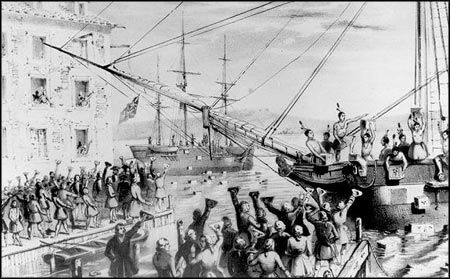The concepts covered in this factsheet go beyond those seen in secondary school. It is intended as a supplement for those who are curious to find out more.
After the creation of the first settlement in 1608 in Virginia, 12 other British colonies were established in North America. All these colonies were populated mainly by immigrants who had left Europe for religious reasons. After the Reformation, followers of new religions were often persecuted. That's why they decided to move to the new continent.
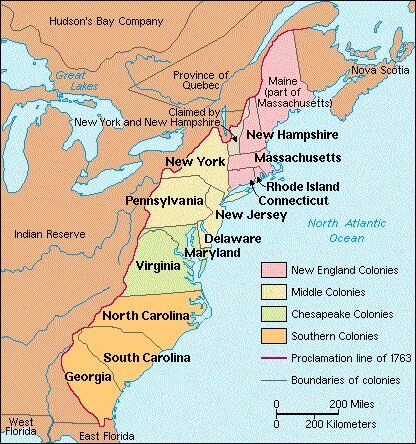
The Thirteen Colonies
Note: English image coming soon
The Thirteen Colonies are divided into three main regions, each with a fairly similar lifestyle.
The northern colonies, also known as the New England colonies, included Massachusetts, Connecticut, Rhode Island and New Hampshire. These colonies were marked by a strong Puritan tradition. The main economic activities are farming and fishing. Boston is also a busy commercial centre with a population of around 20,000.
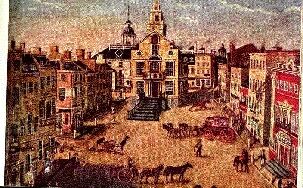
The city of Boston at the end of the 18th century
The central colonies are New York, New Jersey, Delaware and Pennsylvania. The population of these colonies was made up of several immigrant groups: British, Swedish, German and Dutch. The port of New York grew considerably, with a population of 16,000. The most populous city in the region, however, was Philadelphia, with 25,000 inhabitants, making it also the most populous city in the Thirteen Colonies.
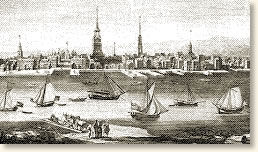
The port of Philadelphia in the 18th century
The southern colonies are Maryland, Virginia, North Carolina and South Carolina. These colonies made their living mainly from tobacco, cotton and rice plantations. The population was made up of wealthy plantation owners and slaves.
At that time, each colony was administered by a governor appointed by the King of England, with the exception of a few colonies that considered themselves autonomous. These colonies (Pennsylvania, Connecticut, Rhode Island, Maryland) elected assemblies to manage their territory.
Social life was marked by numerous philosophical societies. American intellectuals shared the ideas of the Enlightenment. This strong intellectual life explains the rapid creation of numerous universities in the Thirteen Colonies: Harvard University (founded in 1616), Yale University (in 1716) and Princeton University (in 1746).
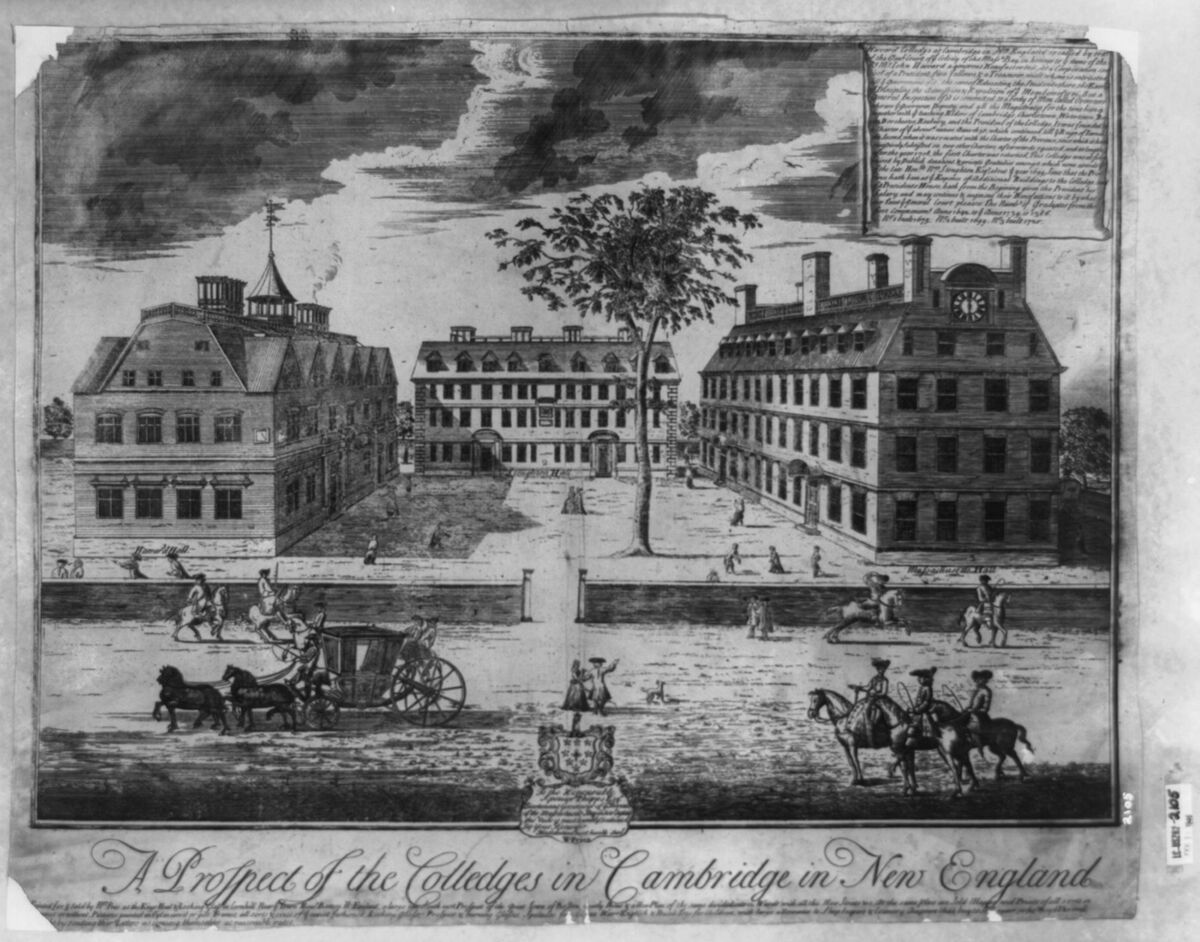
Harvard University in the 17th century
Great Britain fought a long war with France until 1763. It was at the end of this war that Great Britain took possession of the territory of New France.
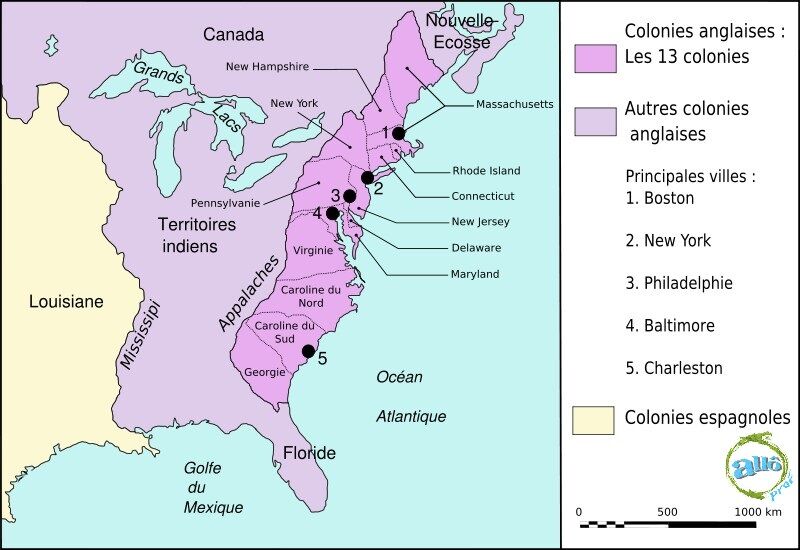
The territory conquered in 1763
Note: English image coming soon
The American settlers saw a positive outcome to this great victory: they would finally be able to extend their territory further west.
As far as the English crown was concerned, the King felt that the war had been very costly. The crown no longer had much money. To remedy the situation, the King adopted a much more rigid attitude to taxation: according to him, it was the population of the colonies that would have to bear the costs of the war, thanks to the taxes imposed on tea, wine, sugar, molasses and newspapers.
The consequences of the Seven Years' War were not all to the advantage of the British colonies. Only the English generals received glory and only the wealthy merchants saw their wealth increase. For the American people, it meant economic collapse and unemployment for the poorest.
The colonists experienced their first frustration when England decided to keep all the newly acquired land. Expansion westwards would not be possible, as the King forbade the colonists to settle in the conquered territory.
After this disappointment, the colonists refused to pay any new taxes. They only wanted to pay taxes created by their own assemblies and their own representatives. They refused to pay any tax for a parliament in which none of their representatives were present. The colonists rely on the following phrase: No taxation without representation.
On September 1st 1763, the Currency Act came into force. This new law prevented the issue of paper money. This decision prevented the colonies from ensuring a more stable economy. On 24 March 1765, the King implemented the Cantonment Act. This law ordered the American people to provide housing for the soldiers. However, in the eyes of the American colonists, 10,000 soldiers to house in peacetime was a considerable number. During the same period, several other laws were passed to raise taxes. The British crown still had the same goal in mind: to increase revenue in order to reduce the debt.
The new taxes introduced between 1763 and 1767 only increased the colonists' frustration. Sensing rising tension, the King ordered more troops to be stationed in the colonies, which helped to escalate the situation even further.
Tensions continued to rise until 5 March 1770. The day was marked by a demonstration that ended with 5 dead. This event is also known as the Boston Massacre.
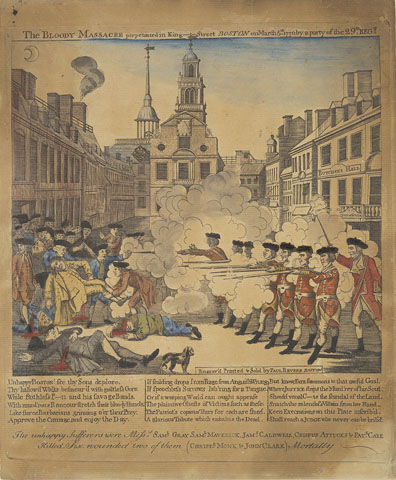
The Boston Massacre
In 1773, Great Britain wanted to save the East India Company, which was also experiencing financial difficulties. To achieve this, taxes were levied on tea from this company. The colonists saw this as unfair competition with other teas.
To show their discontent, the colonists decided to take action. On the night of 16 December 1773, the Boston Tea Party took place. A group of 50 patriots disguised as Aboriginals took possession of an East India Company ship. The insurgents boarded the ship and threw the entire cargo of tea overboard.
Faced with this unexpected event, London decided to radically increase the army's presence in Massachusetts. For their part, the Massachusetts colonists formed several militias and asked the other colonies to rally to their cause.
The King also decided to close the port of Boston until the colony had fully repaid for the tea thrown overboard. Despite the fact that all the colonies rallied to the cause of Massachusetts, the King refused to grant them greater autonomy. Far from favouring the King's cause, this decision meant that the more moderate colonists joined the cause of the more radical ones.
The British Parliament took measures to counter the growing autonomist tendencies in the colonies. On 20 May 1774, Great Britain signed the Quebec Act. This new proposal divided up the American territory in a different way, granting a larger territory to the Province of Quebec.
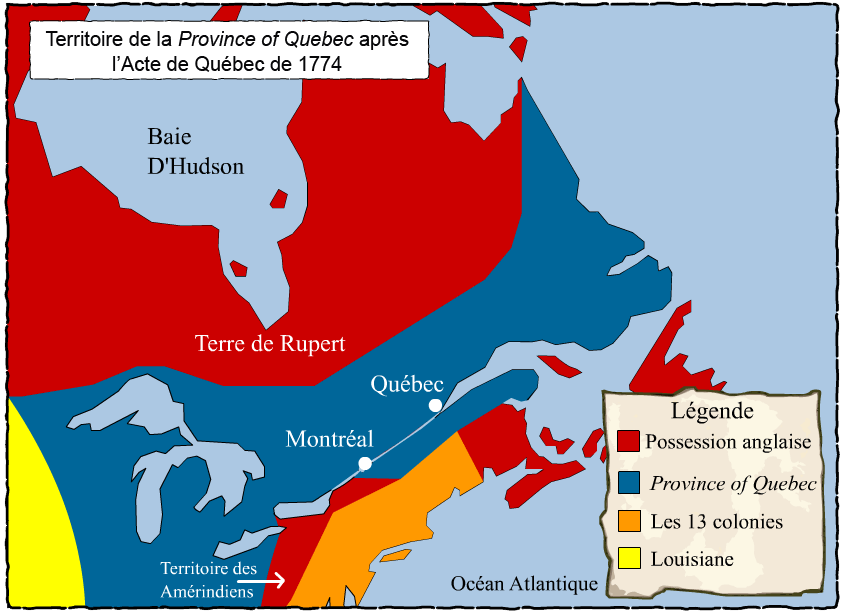
The division of the territory after the Quebec Act
Note: English image coming soon
The American colonists did not accept this decision at all, as New York would lose the opportunity to control the Great Lakes trade to Montreal. The colonists categorically rejected British intervention, which prevented them from protecting their commercial interests. In their view, the metropolis was detrimental to the expansion of New England. What's more, despite the ever-increasing tensions, New England still served as a military base for its metropolis.
On 5 September 1774, the very first Continental Congress opened in Philadelphia. The Congress was made up of 51 representatives from the colonies. It was at this Congress that the members began drafting a Bill of Rights. It was more opposed to the British Parliament than to the power of the King. The Declaration mainly proclaimed the right of the colonies to legislate. It was also during this congress that the Thirteen Colonies decided to unite.
However, this declaration did not soften relations between the colonies and their mother country. The patriots were growing in numbers and becoming increasingly vocal. War against the mother country was being prepared. Groups of insurgents succeeded in gathering arms and gunpowder at Concord. The British took action and decided to arrest Adams and Hancock, two insurgent members of Congress. These two patriots fled and found refuge in Lexington.
On the evening of 18 April 1775, a group of 700 men marched towards Concord. Their aim was to arrest the two wanted insurgents and destroy their stores of arms and ammunition. The people of Concord heard the news early enough to have time to move their ammunition.
The Battle of Concord and Lexington
At dawn on 19 April 1775, the first exchanges of fire took place between the insurgents and the British army. The American militia was forced to retreat. The battle shifted to Lexington, where the American militia found new reinforcements. The British had to retreat towards Boston. This American victory brings the Battle of Concord to a close, and is considered to be the beginning of the Revolutionary War.
The War of Independence continues
For some time, fighting continued between the patriots and the British army. The British evacuated Boston on 17 March 1776 under pressure from the militiamen. The militiamen were under the command of George Washington.
The Declaration of Independence
4 July 1776 marked an important event in American history: Congress adopted the Declaration of Independence. This declaration is considered to be the founding act of the United States and also marks the definitive break with Great Britain.
The numbers on each side
Great Britain managed to send up to 40,000 men at a time to fight against the Patriots. The British could also count on the support of soldiers from Canada.
For his part, George Washington only managed to rally a maximum of 20,000 men who were not trained like soldiers. However, Washington's army was helped by patriotic strength and the will to triumph. In addition, the American patriots had a better knowledge of the territory, which would help them in battle.
The alliance with France
Solicited by the patriots, France saw this war as an opportunity to take revenge on Great Britain. The treaty of 6 February 1778 established friendly trade relations between France and the United States, as well as a military alliance. France was to help the United States thanks to the French navy and ships, and thanks to the capital it was to invest. The Marquis de La Fayette left for the United States, where he obtained the title of Major-General in Washington. For France, this war was seen as a battle for the philosophy of the Enlightenment.
Thanks to the reinforcement of the army obtained by this alliance, the British had to withdraw from Philadelphia. The British army abandoned the fighting in the northern and central colonies. All the fighting that followed was concentrated in the southern colonies, where the British won easily. The War of Independence ended with the Battle of Yorktown in October 1781. The Franco-American alliance won the war thanks to the power of its fleet.
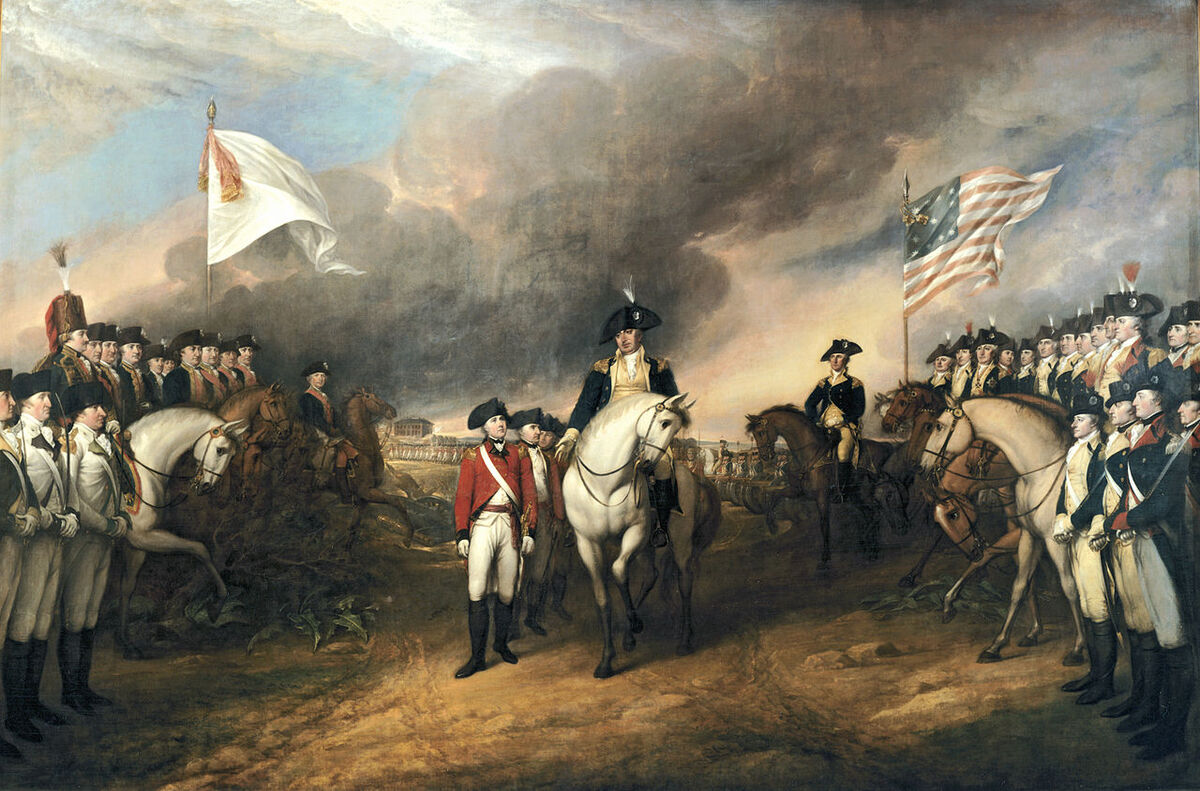
Battle of Yorktown
American independence was officially recognised on 3 September 1783 with the Treaty of Paris. John Adams and Benjamin Franklin signed the treaty on behalf of the United States.
The text recognised American independence and the new country: the United States of America. In addition to independence, the treaty recognised the expansion of the territory, established the borders with Canada and granted fishing rights off the coasts of Newfoundland and Nova Scotia. However, the treaty also recognised the debts that the Americans had to repay and offered amnesty to the Loyalists (those who remained loyal to the British crown), allowing them to settle in the other colonies.
The War of Independence left France in a severe financial crisis. It was this financial crisis that led to the convening of the Estates General and the French Revolution.
France could have expected to become a major financial and commercial partner of the United States and to obtain help in reconquering New France. In both cases, France's ambitions were disappointed, as the United States resumed trade relations with Great Britain and George Washington wanted to oust the colonial powers in America.
What's more, the Americans did not provide the financial aid that would have helped the French to repay the debt. Relations between France and the United States deteriorated further during the years of the Terror.
The Constitution was established after the Declaration of Independence. After the war, the United States was in a difficult situation. The government in power had very little authority over the States. Some of them refused to pay the army and repay the debts, while others wanted a central government to be formed.
Congress convened a Constitutional Convention to which each state had to send one representative. The Constitutional Convention began in May 1787 in Philadelphia and was chaired by George Washington.
The aim of this meeting was to find compromises between those in favour of a central government and those who wanted each state to have more autonomy. The Constitution came into force on 17 September 1787 and established a federal government. In fact, government powers were divided between the federal government and the government of each state. There was also a separation of powers as proposed by Montesquieu (executive, legislative and judicial).
The operation of the federal government ensures equal representation in the Senate (2 seats per state) and proportional representation in the House of Representatives. The government must also manage foreign trade, defence, foreign policy and relations between the states. Each state retains its sovereignty through the following powers: a vote in Congress, the right to declare war, the right to appoint an ambassador, the right to create its own currency, the right to regulate relations with aboriginal peoples and the right to regulate relations with other states.
In 1787, the American Constitution spoke in the name of the American people. However, we need to know what meaning the Constitution gives to the word people. The American people excluded all women, blacks, Aboriginals and servants. In the eyes of the framers of the Constitution, it emphasised the notions of democracy and equality. It should be pointed out that these framers were the 55 richest men in New England. In their view, slavery was a necessary evil.
The Constitution represents a means for them to protect their interests by legalising the inferior social conditions of Aboriginals, Blacks and women. Moreover, it does not necessarily imply universal suffrage to elect representatives and the president.
Public affairs can only be managed by those with wealth, a good education and a family tradition. The same applies to the right to vote: only those who own property can exercise their right to vote. For these rich Americans, the people are to be distrusted.
All the first texts relating to American Independence were written in French, English and German. However, the notion of the national language had never been addressed, which caused some linguistic tensions. For the leaders, English was going to impose itself as the national language without having to proclaim an official language. The Constitution was written solely in English, which put an end to the dithering over the official language of the United States.
George III began his reign in 1760, and his long reign was marked by economic, social and religious change, the War of Independence, the French Revolution and Napoleon's Empire.
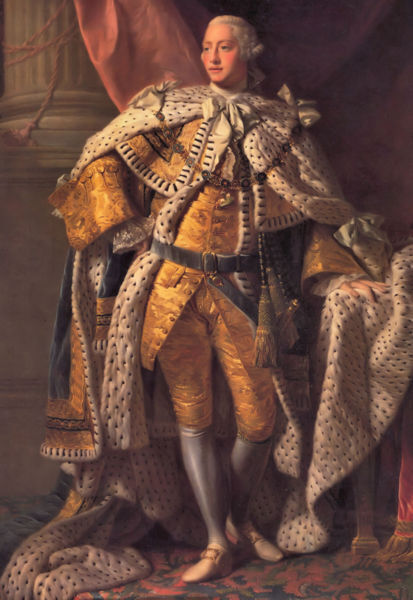
George III
Born in Great Britain, George III was strongly influenced by his mother's training at the German court. This influence made him a very authoritarian king. It was this authoritarian nature that caused friction, strong reactions and even major crises. The War of Independence was provoked by the king's intransigence and his demands of the colonists. Later, George III slowly lost his senses and it was his son who helped him make decisions until his death in 1820.
George Washington was the son of a wealthy Virginia landowning family. By the time he was an adolescent, he was already running the family estate. He joined the British army and fought against the French before becoming an officer and then a colonel. He took a fairly active part in the Seven Years' War, again with the British army. After the war, he acquired a tobacco plantation on which he owned many slaves. He was elected Member of Parliament for Virginia and went to Congress in Philadelphia, where he took part in the insurrection against the government in London.
He returned to military service during the War of Independence, where he was appointed Commander-in-Chief of the insurgent troops. He did not prove to be a very good strategist and had to deal with undisciplined troops and a lack of equipment. However, his troops held out until the victory at Yorktown, achieved with the help of the French. At the end of the war, he presided over the Convention that was to create the Constitution and then be elected President of the United States. His arid policies favoured the economy and the power of the central state.
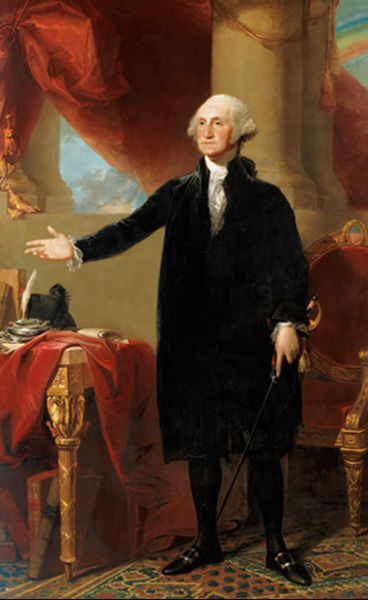
George Washington
The first President of the United States served two terms in office before voluntarily retiring from political life. He took up arms one last time when the French threatened to attack, before dying in glory in 1791. The year after his death, the new capital of the United States was named Washington.
The son of a farmer, John Adams studied at Harvard before settling permanently in Boston. After the Boston Massacre, he was elected Member of Parliament for Massachusetts. Between 1774 and 1778, he was a member of the National Congress.
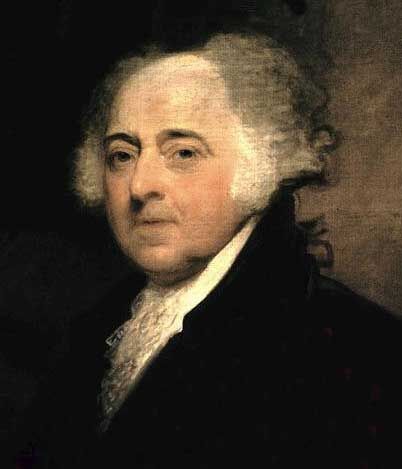
John Adams
He supported the separation of the Thirteen Colonies from Great Britain and championed the American navy. Appointed to the committee that drafted the American Declaration of Independence, Adams was then appointed to negotiate fishing rights with Great Britain.
In 1785, he was the United States ambassador to Great Britain. However, some people disliked him for his radical ideas. Adams defended the idea that the rich and well-born should be given a place in the national assembly. It was for this reason that he failed to be elected President. In 1796, he was finally elected President of the United States. He stood for re-election in 1800, where he was defeated. He withdrew from political life until his death in 1826. John Adams was responsible for the creation of the first American navy.
Thomas Jefferson had a full life. He was a politician, lawyer, philosopher, naturalist, librarian and farmer. His father was a wealthy landowner. He received a refined education from an early age.
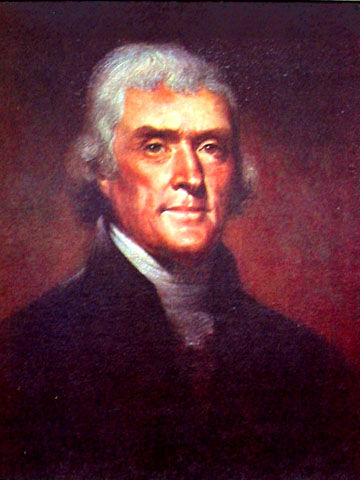
Thomas Jefferson
In 1776, Jefferson became a member of Congress and was one of the people chosen to draft the American Declaration of Independence. During these meetings, he strongly opposed the power of Great Britain and the King. Jefferson also believed that all men are born free and equal. The government of a country is not the master of the people, but their servant. Thanks to his political ideas, Jefferson was elected Member of Parliament for Virginia.
He left the United States to go to France as ambassador. There, he negotiated several trade treaties and kept abreast of scientific progress. He was present at the start of the French Revolution, but never intervened. In 1790, he returned to the United States and became George Washington's Secretary of State..
After founding the Republican party in 1793, he ran for president in 1796, but John Adams won. During Adams' term of office, Jefferson devoted himself to philosophy and science. It was not until 1800 that he stood for re-election. This time he won. He thus became the third President of the United States. He held this position for two terms, during which he bought back Louisiana.
After his terms as President, he retired to Virginia, where he organised book collections before founding the University of Virginia. He died in 1826.
Benjamin Franklin was the son of a Boston craftsman. When he was quite young, he took over his half-brother's printing shop, where he developed his philosophical ideas on freedom of thought, freedom of the people and freedom of opinion.
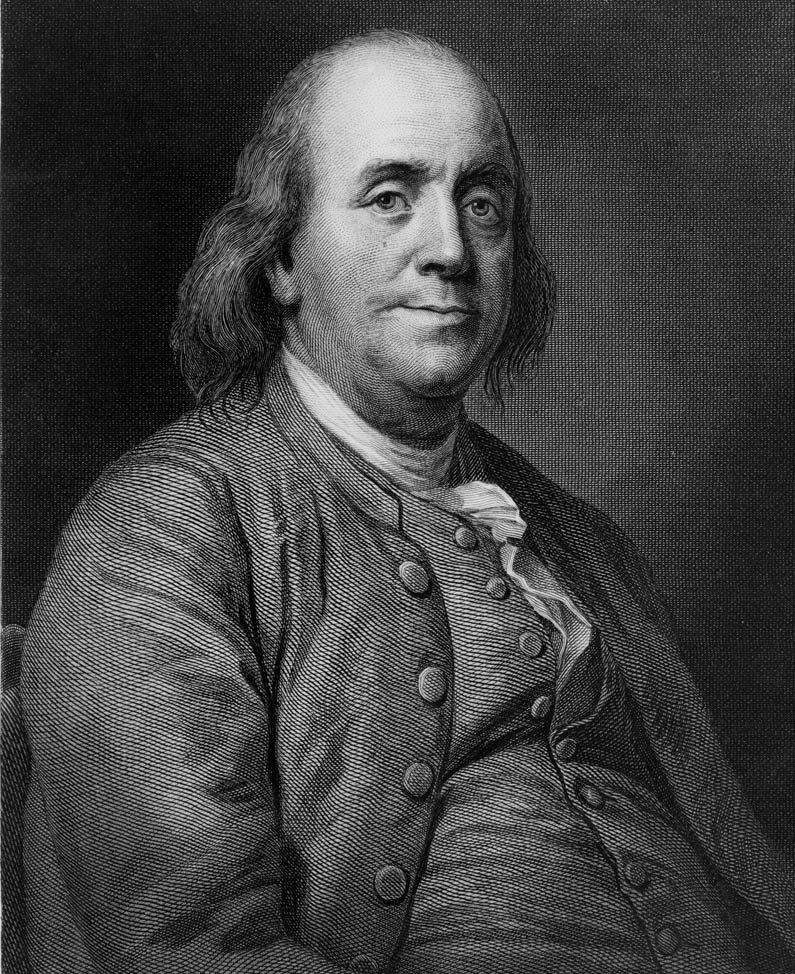
Benjamin Franklin
He left Boston to settle in Philadelphia. It was here that he became a journalist and printer of the most widely read daily newspaper in America. During this time, he founded the first public library in the country, the first fire company, improved the local police force, built a hospital and helped found a university. He also learned several languages and carried out several electrical engineering projects.
Politically, he was an early supporter of independence. In 1776, Benjamin Franklin led the Constitutional Convention in Philadelphia and was one of the drafters of the Declaration of Independence. In October 1776, he was sent to France to embark on a diplomatic career. Franklin was seen there as the embodiment of Enlightenment ideas, which is why he befriended Voltaire.
Franklin was also the US ambassador when France signed the agreement with the United States. What's more, the peace treaty signed in 1783 was drafted by Benjamin Franklin. On his return to the United States, he was elected President of the State of Pennsylvania. He ardently defended the abolition of slavery and helped to draft the American Constitution. He died in 1790.
